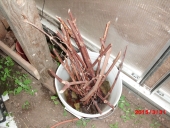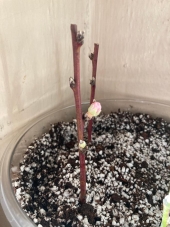I'm about in the middle of NY, up where the mountains start and right at the border of zone 4 and 5 depending on how bizarre the weather is in any given year

Where I grew up there was a gorgeous old mulberry growing from a bank over a creek where a few of us kids spent a whole lot of time in the summer. When I got into propagating later on I went back and snipped a bunch of softwood cuttings from the newest growth and used the method with an upside-down 10 gallon aquarium over a tray filled with peat moss and coarse sand to start what was probably 30 or so cuttings.
If I remember correctly the aquarium was painted with a light covering of white spray paint except for two strips near the bottom (which becomes the top when flipped over and placed on the tray) where I'd used masking tape so there'd be two narrow clear bands to let light in. The cuttings went in and I misted well, and every couple days I'd take the tank off to check on things, mist if needed with my spritzer, and remove any cuttings that had failed (which I usually replaced with a quick cutting of a spirea or something easy to not waste the space).
This would have started in May or June probably since that's when the new growth kicks off on most things around here. The covered trays were kept on the north side of my shed where they didn't get any direct light since that'd turn then into ovens.
By the end of summer the roots were at least a few inches long and the cuttings got moved to old reused nursery pots up on shelves in my little lean-to greenhouse where they'd got some direct sun for an hour or two. If I remember right the mulberries were one of the things I kept the new growth trimmed on, so they'd put most of there energy into rooting - and because they grew quick. Pink pussy willow, butterfly bush, red twig dogwood, and some others done this way can put on new top growth a lot quicker than you want when started from softwood cuttings in spring and you really want them to put more into roots than tops until you get a nice clump of roots on each. Then before the ground got too cold I moved them to one of my nursery beds or a much bigger nursery pot. Doing them, and many other woody shrubs, bushes, and fruit trees from softwood cuttings in the spring this way is a lot easier and usually a bit faster than hardwood cuttings from dormant growth from my experience, at least in colder areas - and the success rate is higher. Plus you have the benefit of being able to go back for semi-hardwood cuttings a few weeks later if the first batch meets some misfortune.









 Where I grew up there was a gorgeous old mulberry growing from a bank over a creek where a few of us kids spent a whole lot of time in the summer. When I got into propagating later on I went back and snipped a bunch of softwood cuttings from the newest growth and used the method with an upside-down 10 gallon aquarium over a tray filled with peat moss and coarse sand to start what was probably 30 or so cuttings.
Where I grew up there was a gorgeous old mulberry growing from a bank over a creek where a few of us kids spent a whole lot of time in the summer. When I got into propagating later on I went back and snipped a bunch of softwood cuttings from the newest growth and used the method with an upside-down 10 gallon aquarium over a tray filled with peat moss and coarse sand to start what was probably 30 or so cuttings.

 For most hardwood cuttings like you're using one of the key principles is warm bottoms/cool tops. I had exactly the same result as you with early attempts and it was because the air temp was getting too high - his methods make it easier to maintain the soil moisture too. Your cuttings need no light at all in the early stages, they need warm soil first to grow system. Once they have roots they can then start to get indirect sun and try to leaf out.
For most hardwood cuttings like you're using one of the key principles is warm bottoms/cool tops. I had exactly the same result as you with early attempts and it was because the air temp was getting too high - his methods make it easier to maintain the soil moisture too. Your cuttings need no light at all in the early stages, they need warm soil first to grow system. Once they have roots they can then start to get indirect sun and try to leaf out.
 I hope to eventually have the same kind of experience at our new home, once I've gotten conditions improved enough.
I hope to eventually have the same kind of experience at our new home, once I've gotten conditions improved enough.

 Your perspective on homesteading for us not-so-young folks and some of your tips and experiences helped me when I was thinking about moving to a more rural area and getting some land years ago. I remember finding info on chicken/compost ideas and also egg storage without power, and recently some of those tidbits resurfaced to mix with others I'd seen over the years as I began my own journey with keeping chickens and trying to find ways to build healthy soil. Great to have the perspective of someone who's been in a more similar situation for those of us who couldn't get started sooner or do quite so much.
Your perspective on homesteading for us not-so-young folks and some of your tips and experiences helped me when I was thinking about moving to a more rural area and getting some land years ago. I remember finding info on chicken/compost ideas and also egg storage without power, and recently some of those tidbits resurfaced to mix with others I'd seen over the years as I began my own journey with keeping chickens and trying to find ways to build healthy soil. Great to have the perspective of someone who's been in a more similar situation for those of us who couldn't get started sooner or do quite so much.

